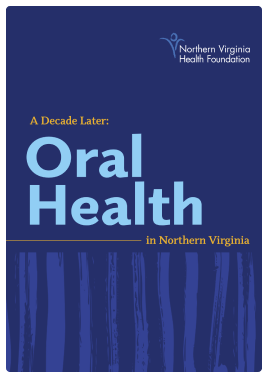A Decade Later: Oral Health in Northern Virginia

The Issue
Despite increases in oral health coverage across Northern Virginia, findings from a 2019 Northern Virginia Health Foundation (NVHF) survey revealed the disproportionate challenge lower-income residents face when trying to get dental care services they need.
The findings, based on a survey of 3,023 adults living in Northern Virginia, reveal how starkly different oral health care experiences are for lower-income households (defined as those with an annual income below $50,000) compared to their wealthier neighbors. The results of the survey, conducted in October 2019, appear in the NVHF report A Decade Later: Oral Health in Northern Virginia, which measures progress in the region since NVHF conducted the first region-wide oral health survey in 2010.
What the Study Found
Cost is a significant concern for lower-income Northern Virginians: More than three-fourths (77%) of lower-income adults say they did not see a dentist because they could not afford it. This is up from 66% in 2010.
Fewer Northern Virginians saw a dentist than in 2010: Just more than half (56%) of lower-income adults have seen a dentist or dental hygienist in the last two years compared to 83% of higher-income adults. Both groups saw declines from 2010 (lower-income residents decreased from 63% in 2010, and higher-income residents decreased from 91%).
Oral health care experiences vary dramatically for pregnant women depending on income: Pregnant women in higher-income households were significantly more likely than pregnant women in lower-income households to say they saw a dentist for a regular checkup (59% compared to 28%). At the same time, 22% of lower-income pregnant women reported having problems with their teeth and gums but did not see a dentist, compared to just 8% of higher-income pregnant women.
Lack of coverage continues to deter many residents from seeing the dentist: Lower-income adults were twice as likely as higher-income adults (59% compared to 26%) to cite a lack of dental coverage as the reason for not seeing a dentist. Percentages decreased slightly for both groups since 2010 (66% of lower-income adults and 30% of higher-income adults).
Lack of dental insurance coverage prevents many lower-income children from receiving care: Among the respondents whose children have not seen a dentist in the last two years, 30% of lower-income parents cited lack of dental insurance coverage as the reason, compared to just 9% of higher-income parents.
Poor oral health affects the daily lives of lower-income adults: Among lower-income adults, oral health problems keep 29% from sleeping and 18% from engaging in regular activities. The corresponding numbers for higher-income residents are significantly less: 12% can’t sleep and 10% can’t do their regular activities. The percentages for both groups increased from 2010.
Recommendations
The recommendations put forward in this report did not change from those in 2010, and there has been little action to address them, the report says. The report outlines several short- and long-term strategies for improving the state of oral health in Northern Virginia, including increasing reimbursements rates for dental services provided through Medicaid; increasing the number of providers who offer reduced-cost oral health care to lower-income adults; and ensuring that dental hygienists and other dental professionals are able to practice to the full extent of their education and training.